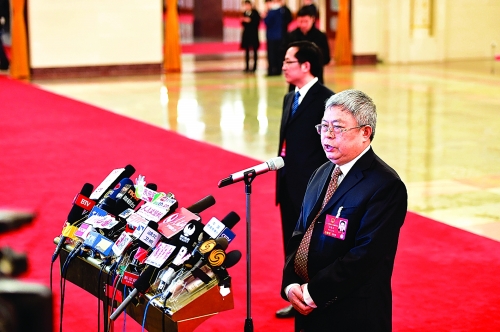Transitions in and out of poverty
chinagate.cn by Zhang Ling, August 17, 2016 Adjust font size:

Liu Yongfu, Director of the State Council Leading Group Office of Poverty Alleviation and Development, speaks at a conference during the "Two Sessions" in Beijng on March 16 when talking about the poverty issue in China. [Xinhua]
Editor's notes: "Those in China who have returned to poverty have never been taken out of extreme poverty. Poverty reduction is inseparably linked with stable income, great individual capability and ever-changing social awareness," said Liu Yongfu, Director of the State Council Leading Group Office of Poverty Alleviation and Development (LGOPAD).
Liu pointed out that people in China who shake off poverty return to poverty in a matter of years due to the benefits of "being poor." Similarly, the rate of people returning to poverty seems to increase because more individuals fall into poverty or fewer find ways to escape it, infzm.com reported.
Lack of Motivation and Enthusiasm
infzm.com (Q): How many poor people are there in China? Statistics released by the government show that a total of 55.75 million people were trapped in poverty. New figures published by LGOPAD recently revealed that there were still more than 56 million poor people across China. Is there anything wrong with them?
Liu Yongfu (A): The National Bureau of Statistics (NBS) annually collected data from the income of registered rural households and then published its Poverty Monitoring Report of Rural China before 2014. Since last year, China has initiated a wide-scale fight against poverty and launched targeted measures in its poverty alleviation campaign. Data is set to become more accurate than ever with the launch of a new tool—creating poverty alleviation files. 2014 witnessed a great deal of difference between the figures collected from the NBS and LGOPAD. However, in 2015, the calculations were narrowed down from 7 million to 700,000.
Q: Which figure should we refer to?
A: People should refer to the data released by the NBS to get a better understanding about the current situation and recent development of the Chinese government's anti-poverty efforts, while people can often refer to the latter one once they are devoted to poverty alleviation and reduction programs.
Q: How about the distribution of the poor population throughout the country?
A: Poverty can often be classified into two general categories, relative poverty and absolute poverty. The former was adopted by a few countries to measure their poverty and refers to a cutoff point in relation to the overall distribution of income or consumption in a given country, while the latter represents a fixed standard of what households should be able to count on in order to meet their minimal needs of survival. Those households in absolute or extreme poverty might be the poorest people in the world, and these households are not limited to rural areas. Therefore, most countries in the world measure their poverty using an absolute threshold.
In China, absolute poverty is frequently recognized as follows, the number of poor residents in Beijing, Tianjin, Shanghai, Jiangsu and Zhejiang amounts to zero. A large number of poor people are widely distributed over China's central regions and southwestern provinces; the other poor people are narrowly concentrated in northwestern China, while Tibet is the most concentrated poor region in China, followed by the Xinjiang Uyghur Autonomous Region and Gansu Province.
Q: What are the causes of poverty? Do they share similarity?
A: The causes of poverty are incredibly diverse. Some households are stuck in poverty for only one reason while others, who live in extreme poverty or are at the greatest risk of falling into deep poverty, are in that situation for two or three reasons. Disease is the main reason that pushes the poor into situations of extreme poverty, accounting for 42 percent of all reasons. A lack of money and a shortage of technique follow closely after disease with almost 30 percent of the reasons respectively.
Q: Li Yining, a member of the 12th National Committee of the Chinese People's Political Consultative Conference (CPPCC), said that gambling might be viewed as one of the reasons to revoke Ankang residents in Shaanxi of their poor status earlier in March during the "Two Sessions" when conducting a census there. What is your view about it?
A: It is true but rarely seen across China. I think it is an exceptional case. Actually, according to our figures above, those people who don't want to rise out of poverty make up 3 percent of the poor because they are short of motivation and enthusiasm to change their fate. What's more, they are used to being fully supported by the central and local governments and don't even know how to shake off poverty.
Q: You have just mentioned some specific reasons. Are there any reasons related to rural systems? Would the household registration (Hukou) system or the price scissors, to some extent, have an effect on rural people as they embark on their next step out of poverty?
A: The price scissors that are usually measured in terms of the agricultural parity ratio consistently favored the urban over the rural in the past. For a long period, the price scissors and Hukou posed serious challenges to farmers, which later contributed to special problems in rural areas. Nowadays, China has strengthened its agricultural policy support for rural people, deepened rural reform, provided subsidiaries for farmers and launched development-oriented poverty reduction programs.
These human-centered policies have shown a significant improvement. Don't you think this represents a satisfaction guarantee for rural people? Of course, the long-used rural system has an effect on locals but the effect is becoming weaker and weaker as time goes on.